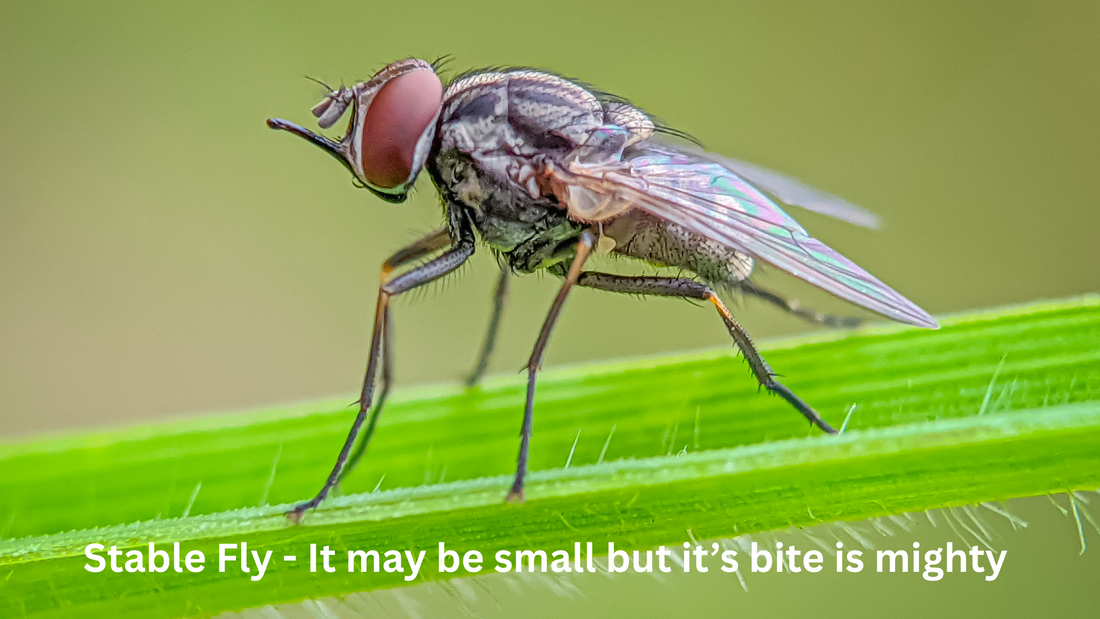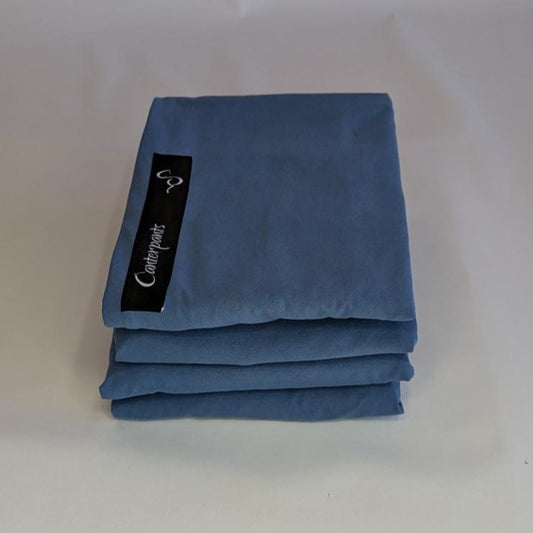Stable Flies and Their Impact on Horses: What Every Horse Owner Should Know

If you’ve ever seen your horse on a warm day stomping their feet and swishing their tail furiously, chances are you’re witnessing the nuisance of stable flies. These persistent little insects are more than just annoyance – they can cause real discomfort, health issues and stress for our horses.
In this HorseTalk, we take a closer look at what stable flies are, why they’re such a problem in Australia and most importantly, how you can reduce their impact on your horses by both minimising bites and preventing them from breeding.
What are Stable Flies?
Stable flies (Stomoxys calcitrans) look a lot like the common house fly, but they’re far more troublesome. Unlike houseflies, stable flies bite. They feed on blood and prefer the lower legs and belly of horses, which is why you’ll often see horses stomping their hooves in irritation.
Stable flies are most active in warm, humid conditions, particularly during spring and summer in Australia. After feeding on blood the females lay their eggs in moist organic matter, such as damp hay, manure piles or soiled bedding. After hatching they can travel several kilometres to find hosts and breeding sites.
While they can be found throughout Australia, they are a declared pest on the coastal plain, north and south of Perth in Western Australia.
How do I recognise the Stable Fly?
The first thing that will probably alert you to stable flies is their bite. They draw blood and once one fly bites it attracts others, often in swarm-like numbers, covering large areas of the animal. And if you get bitten, yourself, you’ll understand how much their bites hurt.
Physically, they are slightly smaller than a house fly and slightly larger than a bushfly, but the most prominent feature is their black proboscis, used to pierce the skin to draw blood.
How Stable Flies Affect Horses
Stable flies may be small, but their impact can be significant:
· Constant irritation – Horses can spend much of the day fighting off flies rather than grazing, resting or working calmly
· Skin reactions - Bites can cause painful welts, swelling, hair loss and even open sores if horses continually bite or rub the area
· Stress and behaviour changes – Being continually bitten can lead to restlessness, loss of focus in work, or injury from rubbing, biting or stomping excessively
· Potential for disease transmission -While less common in Australia than in some other parts of the world stable flies can spread certain pathogens and parasites
· Reduced condition – Horses distracted by flies can lose weight, either from less time eating, or from excessive energy used in stomping, biting, rubbing or other means to dislodge these pests
Reducing Stable Fly Bites
The first step to protecting your horse is by making them less attractive – or less accessible – to flies. Some practical measures include:
1. Protective Gear
· Leg protection: Since stable flies target the lower legs, leg protection is one of the most effective barriers
· Fly rugs and masks: Stable flies are persistent and will target any exposed areas, so rugs and face masks are also important
· Topical repellents: Sprays, rinses and roll-ons can deter flies, although they will usually require regular reapplication and you should be careful to ensure they do not irritate your horse
2. Environmental Management
· Provide shady resting spots: Flies are less active in cooler, shaded areas
· Fans in stables: Air movement makes it harder for flies to land and bite
3. Natural Allies
Some horse owners find success using fly predators (tiny wasps that target fly larvae) or encouraging insect-eating birds to nest nearby
Inhibiting Breeding – Tackling the Source
Protecting your horse directly is important, but if you don’t control where stable flies breed you’ll be fighting an uphill battle. Their lifecycle is short (as little as three weeks in warm weather), so breaking it makes a big difference.
1. Manure Management
· Pick up droppings daily in stables, yards and high-use paddock areas
· Compost correctly – a hot compost heap (high-temperature rapid decomposition process) will destroy fly larvae, but a neglected pile becomes a breeding ground
2. Bedding and Hay
· Remove wet or spoiled hay promptly
· Replace damp or soiled bedding regularly – don’t let it build up
3. Drainage
· Fix leaky taps and eliminate standing water around troughs and feed areas. Flies love moist spots where organic matter collects
4. Chemical Control
· Strategic use of insecticides can help reduce breeding sites, but these should be part of an integrated management plan rather than the sole solution
More you Can Do to Reduce Stable Flies
Doing your bit for your horses and sanitary property management to inhibit breeding may not be enough. Because these flies can travel several kilometres seeking blood, your horses may become targets from sources outside your property and outside your control.
There are things every property owner should do if they find Stable Flies on their property:
1. Report it to your local authority and/or the Stable Fly Action Group. There is strength in numbers. You can find a list of the 14 designated local government areas here
2. Do your bit to break the lifecycle of the Stable flies by protecting your horses and ensuring your property is clear of potential breeding sites
3. Keep informed by following the latest information about this pest
4. Report unsanitary practices to alert authorities of potential breeding sites
It is incumbent on all of us to minimise Stable Fly breeding. Take a look at the Biosecurity and Agriculture Management (Stable Fly) Management Plan 2019, issued by the Western Australian Government. A link has been included in the related resources section below along with other resources related to Stable Fly.
A Practical Routine for Horse Owners
To put it all together, here’s a simple daily and weekly routine that can make a big impact:
· Daily: Pick up manure, check rugs, masks and leg protection and reapply repellents if needed.
· Weekly: Refresh bedding, turn compost heaps, and inspect paddock drains or damp spots.
· Seasonally: Rotate rugs, clean out water troughs, and review whether extra measures (such as fly predators) are needed.
Final Thoughts
Stable flies might be small, but their effects on our horses can be huge. By combining protective gear, repellents, good stable management and breeding control you can keep your horses more comfortable and reduce the overall fly population around your property.
And in areas where stable flies are declared pests, please help reduce the numbers of flies by reporting to your local government authority and the Stable Fly Action Group.
🐴Together - making our horses’ lives better – Yvette
Related HorseTalk blogs:
Insect Bite Hypersensitivity (IBH) in Horses
Is Insect Repellent Harmful to my Horse?
Related Resources:
Department of Primary Industries and Regional Development (DPIRD) - Stable Fly
DPIRD Frequently Asked Questions – Stable Fly Management in Western Australia – May 2025
Stable Fly Action Group (Website)
Disclaimer: These are my thoughts and opinions and should not be considered expert or medical advice. I recommend that you seek professional advice in relation to your horse/s.










